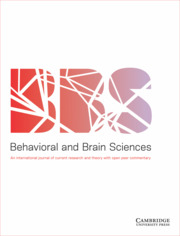Crossref Citations
This article has been cited by the following publications. This list is generated based on data provided by
Crossref.
Verweij, Marco
Senior, Timothy J.
Domínguez D., Juan F.
and
Turner, Robert
2015.
Emotion, rationality, and decision-making: how to link affective and social neuroscience with social theory.
Frontiers in Neuroscience,
Vol. 9,
Issue. ,
Gow, David W.
and
Olson, Bruna B.
2016.
Using effective connectivity analyses to understand processing architecture: response to commentaries by Samuel, Spivey and McQueen, Eisner and Norris.
Language, Cognition and Neuroscience,
Vol. 31,
Issue. 7,
p.
869.
Raz, Gal
Touroutoglou, Alexandra
Wilson-Mendenhall, Christine
Gilam, Gadi
Lin, Tamar
Gonen, Tal
Jacob, Yael
Atzil, Shir
Admon, Roee
Bleich-Cohen, Maya
Maron-Katz, Adi
Hendler, Talma
and
Barrett, Lisa Feldman
2016.
Functional connectivity dynamics during film viewing reveal common networks for different emotional experiences.
Cognitive, Affective, & Behavioral Neuroscience,
Vol. 16,
Issue. 4,
p.
709.
Ottmar, Erin
and
Landy, David
2017.
Concreteness Fading of Algebraic Instruction: Effects on Learning.
Journal of the Learning Sciences,
Vol. 26,
Issue. 1,
p.
51.
Pacella, Daniela
Ponticorvo, Michela
Gigliotta, Onofrio
Miglino, Orazio
and
Tamietto, Marco
2017.
Basic emotions and adaptation. A computational and evolutionary model.
PLOS ONE,
Vol. 12,
Issue. 11,
p.
e0187463.
Oosterwijk, Suzanne
Snoek, Lukas
Rotteveel, Mark
Barrett, Lisa Feldman
and
Scholte, H. Steven
2017.
Shared states: using MVPA to test neural overlap between self-focused emotion imagery and other-focused emotion understanding.
Social Cognitive and Affective Neuroscience,
Vol. 12,
Issue. 7,
p.
1025.
Pisner, Derek A.
Smith, Ryan
Alkozei, Anna
Klimova, Aleksandra
and
Killgore, William D. S.
2017.
Highways of the emotional intellect: white matter microstructural correlates of an ability-based measure of emotional intelligence.
Social Neuroscience,
Vol. 12,
Issue. 3,
p.
253.
Edelman, Shimon
2017.
Language and other complex behaviors: Unifying characteristics, computational models, neural mechanisms.
Language Sciences,
Vol. 62,
Issue. ,
p.
91.
de Wit, Matthieu M.
de Vries, Simon
van der Kamp, John
and
Withagen, Rob
2017.
Affordances and neuroscience: Steps towards a successful marriage.
Neuroscience & Biobehavioral Reviews,
Vol. 80,
Issue. ,
p.
622.
Celeghin, Alessia
Diano, Matteo
Bagnis, Arianna
Viola, Marco
and
Tamietto, Marco
2017.
Basic Emotions in Human Neuroscience: Neuroimaging and Beyond.
Frontiers in Psychology,
Vol. 8,
Issue. ,
de Jesus Dias Martins, Mauricio
and
Di Paolo, Laura Desirèe
2017.
Hierarchy, multidomain modules, and the evolution of intelligence.
Behavioral and Brain Sciences,
Vol. 40,
Issue. ,
Williams, Daniel
and
Colling, Lincoln
2018.
From symbols to icons: the return of resemblance in the cognitive neuroscience revolution.
Synthese,
Vol. 195,
Issue. 5,
p.
1941.
Murphy, Elliot
and
Benítez-Burraco, Antonio
2018.
Toward the Language Oscillogenome.
Frontiers in Psychology,
Vol. 9,
Issue. ,
Van Den Herik, Jasper C.
2018.
Attentional actions – an ecological-enactive account of utterances of concrete words.
Psychology of Language and Communication,
Vol. 22,
Issue. 1,
p.
90.
Williams, Daniel
2018.
Predictive Processing and the Representation Wars.
Minds and Machines,
Vol. 28,
Issue. 1,
p.
141.
Strickland, James
Martin, Katie
Allan, Alfred
and
Allan, Maria M.
2018.
An explanation of apology acceptance based on lay peoples’ insights.
Interpersona: An International Journal on Personal Relationships,
Vol. 12,
Issue. 1,
p.
68.
Ottmar, Erin R.
2018.
Book review of “Development of mathematical cognition: Neural substrates and genetic influences” (2016) edited by D. B. Berch, D. C. Geary, & K. M. Koepke.
Journal of Numerical Cognition,
Vol. 3,
Issue. 3,
p.
716.
Kolodny, Oren
and
Edelman, Shimon
2018.
The evolution of the capacity for language: the ecological context and adaptive value of a process of cognitive hijacking.
Philosophical Transactions of the Royal Society B: Biological Sciences,
Vol. 373,
Issue. 1743,
p.
20170052.
Wood, Michael Lee
Stoltz, Dustin S.
Van Ness, Justin
and
Taylor, Marshall A.
2018.
Schemas and Frames.
Sociological Theory,
Vol. 36,
Issue. 3,
p.
244.
Allan, Alfred
2018.
Applying Research Findings to Enhance Pre-Practicum Ethics Training.
Ethics & Behavior,
Vol. 28,
Issue. 6,
p.
465.



Target article
Précis of After Phrenology: Neural Reuse and the Interactive Brain
Related commentaries (14)
A registration problem for functional fingerprinting
After phrenology: Time for a paradigm shift in cognitive science
Becoming an expert: Ontogeny of expertise as an example of neural reuse
Beyond disjoint brain networks: Overlapping networks for cognition and emotion
Computational specificity in the human brain
Modularity in network neuroscience and neural reuse
Multisensory integration substantiates distributed and overlapping neural networks
Neural reuse leads to associative connections between concrete (physical) and abstract (social) concepts and motives
Reason for optimism: How a shifting focus on neural population codes is moving cognitive neuroscience beyond phrenology
Scientific intuitions about the mind are wrong, misled by consciousness
The implications of neural reuse for the future of both cognitive neuroscience and folk psychology
The reification objection to bottom-up cognitive ontology revision
Toward mechanistic models of action-oriented and detached cognition
Why a developmental perspective is critical for understanding human cognition
Author response
Reply to reviewers: Reuse, embodied interactivity, and the emerging paradigm shift in the human neurosciences